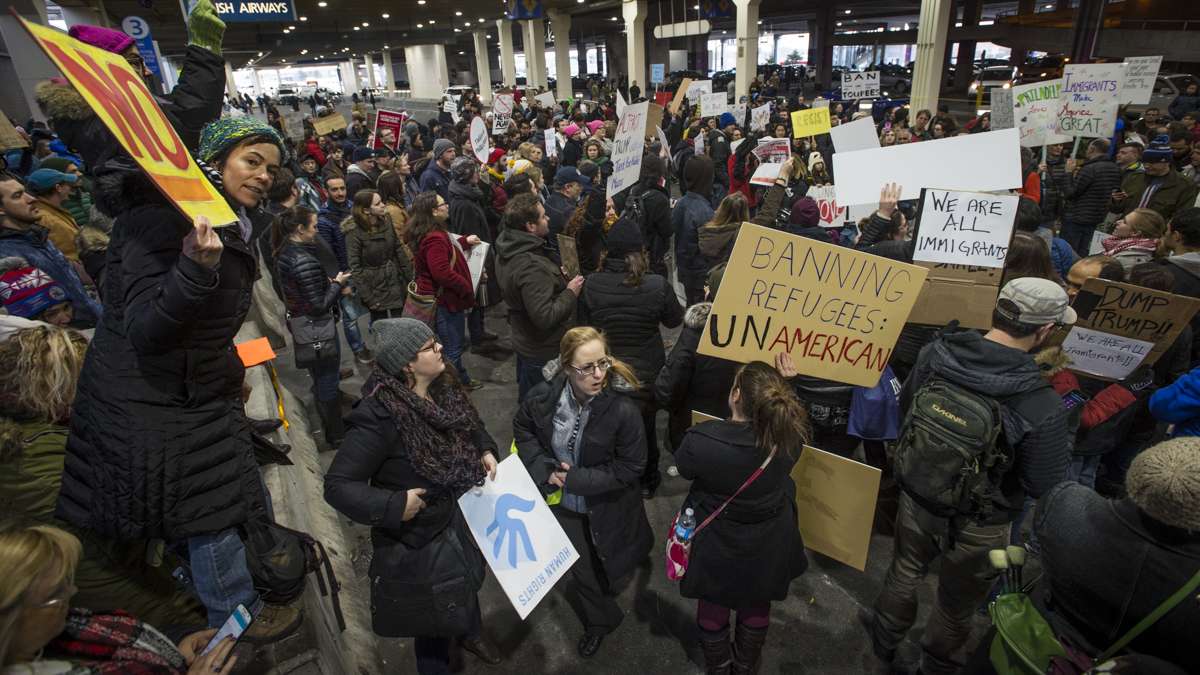In Trump’s first year, Philly’s ‘sanctuary city’ label led to more arrests, lawsuits
ICE officers arrested 3,600 people across Pennsylvania, Delaware and West Virginia in budget year 2016. The next year, 5,000 were arrested.
Listen 4:30
Protesters opposed to Donald Trump’s executive order on immigration march outside of Terminal A at Philadelphia International Airport. (Branden Eastwood for NewsWorks)
Five days into his first term, President Donald Trump issued an executive order taking aim at “sanctuary jurisdictions,” characterizing them as willful law-breakers rending the “very fabric of our Republic.”
As the first anniversary of Trump’s inauguration approaches, the sanctuary term has taken on a life of its own in Philadelphia. It’s become both a rallying cry for pro-immigrant groups and an ongoing accusation from federal officials.
Somewhere in between is the reality — that cities and towns have their own reasons for not detaining immigrants at the request of U.S. Immigration and Customs Enforcement, and that the ability of ICE to enforce federal immigration laws would be greatly multiplied if more places did.
In the courts
The term is a blanket label for any jurisdiction — state, county, or city — that does not go out of its way to assist immigration law enforcement and arrests.
In Philadelphia, that means not bringing immigration status into a criminal investigation, as well as not honoring appeals by ICE officers to hold undocumented immigrants in police custody for 48 hours.
“The reason we have a policy where we don’t get into people’s status is there’s a lot of fear,” said Philadelphia city solicitor Sozi Tulante. “If we have people who are concerned or scared that their status is shared with ICE, they’re not going to come forward.”
In Philadelphia, reducing crime is more of a priority at the local level than facilitating immigration arrests.
ICE officials have alleged that these policies make it harder to deport convicted criminals.
In August, Philadelphia sued the U.S. Department of Justice for withholding public safety grants that came with three new conditions demanding greater cooperation with immigration enforcement. To get $1.6 million in funds for overdose-prevention efforts, Philadelphia was required to prove it shared information with the Department of Homeland Security; give ICE complete access to city jails; and give 48-hours notice before releasing someone for whom ICE had requested notice.
U.S. District Judge Michael Baylson ruled in November that Philadelphia satisfied the first demand, and that the second and third conditions are “likely unconstitutional.”
On Tuesday, the Department of Justice appealed that decision.
Even in ‘sanctuary city,’ more arrests last year
ICE officials have said repeatedly that not being allowed to pick people up from county jails makes their jobs more difficult and dangerous.
“ICE is forced to dedicate more resources to conduct at-large arrests in these communities,” said DHS director Tom Homan in September.
Without access to jail populations, ICE has turned to making arrests not only in neighborhoods and workplaces, but also in Philadelphia federal and common pleas courts, whether or not the unauthorized immigrants have a criminal record. Breaking immigration law is a civil, not a criminal, offense.
Federal immigration enforcement publicized arresting 107 people in Philadelphia during a single four-day span in September as part of “Operation Safe City.” During that operation, Philadelphia had more arrests than any of the other “sanctuary” jurisdictions specifically targeted.
Arrest by officers from the Philadelphia field office also rose dramatically in the last year.
Immigration enforcement officers arrested 3,600 people across Pennsylvania, Delaware and West Virginia in budget year 2016, according to ICE officials. The next year, that number was 5,000.
A label, what is it good for?
So who uses the term sanctuary cities?
It’s not the Philadelphia city officials themselves.
“We do not use sanctuary cities because there is no definition of sanctuary cities. We prefer welcoming cities,” said Miriam Enriquez, head of the Mayor’s Office of Immigrant Affairs, of Philadelphia’s immigrant-friendly policies. Mayor Jim Kenney has been critical of federal immigration policy under Trump, and his administration is exploring municipal IDs and other measures to make life easier for unauthorized immigrants.
The Department of Homeland Security uses the term in its releases about arrests in those jurisdictions, in a way that implies those cities are harboring dangerous criminals.
“Non-cooperation policies severely undermine [law enforcement] efforts at the expense of public safety,” said Homan.
The media also use the term, as a convenient shorthand for a number of issues related to local responses to federal immigration policy.
In the past year, pro-immigrant groups have weaponized the term as well, trying to rally for even more immigrant-friendly policies.
“Under the Trump administration, the idea of a sanctuary city has become this symbol of migrant justice throughout the country,” said Sheila Quintana, a community organizer with the New Sanctuary Movement. “It has mobilized a lot of people around it, and it has pushed people to take stances, and pushed cities to take stances when the federal government was targeting them.”
So, whether the term sanctuary city is a criticism, a symbol of hope, or a misnomer depends on who is invoking it.
WHYY is your source for fact-based, in-depth journalism and information. As a nonprofit organization, we rely on financial support from readers like you. Please give today.




